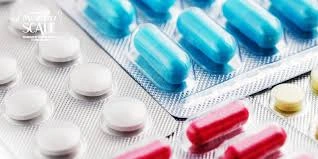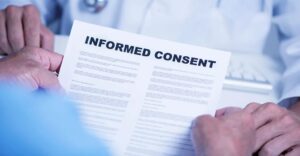Eszopiclone
Eszopiclone is a nonbenzodiazepine hypnotic drug. It is the active stereoisomer of zopiclone, belonging to the class of drugs known as cyclopyrrolones.1,12- Cyclopyrrolone drugs demonstrate high efficacy and low toxicity, offering a safer alternative to other drugs used for insomnia.
One major benefit of eszopiclone is that it is approved by the FDA for the long-term treatment of insomnia. This sets it apart from many other hypnotic sedatives, which are generally approved only for the relief of short-term (6-8 weeks) insomnia.
Eszopiclone is used for the treatment of insomnia, which may be due to problems with falling asleep, staying asleep, or early wakening. It is unrelated to other sleep medications such as benzodiazepines and barbiturates. Eszopiclone is rapidly absorbed after ingestion and has a fast onset of action. It has a short duration of action, and most of the medication is eliminated from the body in about 6 hours. For this reason, eszopiclone appears to cause little daytime sedation and drowsiness.
- When taken at bedtime, eszopiclone may decrease the time to fall asleep and may improve sleep maintenance through the night.
Eszopiclone is a prescription medication classified as a Schedule IV controlled substance. Although eszopiclone’s chemical structure is unrelated to the structures of benzodiazepines, it shares many pharmacological properties with benzodiazepines.
- The FDA did not limit eszopiclone’s indication for short-term use as with other sleep medications and approved eszopiclone for long-term treatment of insomnia and sleep maintenance.
What is the recommended dose of Eszopiclone?
The recommended starting dose is 1 mg. Dosing can be raised to 2 mg or 3 mg if clinically indicated.
In some patients, the higher morning blood levels of eszopiclone following use of the 2 mg or 3 mg dose increase the risk of next-day impairment of driving and other activities that require full alertness.
- The total dose of eszopiclone should not exceed 3 mg, once daily, immediately before bedtime. The total dose of eszopiclone should not exceed 2 mg in elderly or debilitated patients.
What happens when you take an overdose of Eszopiclone?
Clinical experience with eszopiclone overdoses is minimal. In one documented instance, a person who had taken up to 36 mg of eszopiclone overdosed and recovered completely.
- Naturally, the amount of sleep medicine used in total as well as whether it was taken in conjunction with other medications, particularly CNS depressants, will be needed to determine how severe the overdose is.
Every potential overdose of eszopiclone should be considered an emergency at the ER. The prescription of a bottle of drug along with any extra drugs linked to the overdose should also be brought, as the data on the prescription label can help the treating physician estimate the quantity of pills consumed.
What are the side effects of Eszopiclone administration?
The most often mentioned side effects associated with eszopiclone include fatigue, lightheadedness, dizziness, and impaired coordination. Eszopiclone’s short half-life makes it unlikely that it will produce sleepiness or sedation during the day.
- However, if taking a high dose, some patients, especially the elderly, may feel sleepy during the day. The easiest way to prevent sedation is to take the lowest amount that allows you to fall asleep at night and stay away from other sedatives like alcohol and antihistamines. Incoordination, a dissociative or “spacey” mood, and memory and attention problems are other sporadic concerns.
More common side effects
Chills, cough, fever, hoarseness, lower back or side pain, painful or difficult urination, and sleepiness or unusual drowsiness.
Less common side effects
Bladder pain, bloody or cloudy urine, confusion, diarrhea, discouragement, fear or nervousness, feeling sad or empty, a frequent urge to urinate, a general feeling of discomfort or illness, Headache, Irritability, joint pain, lack of appetite, loss of interest or pleasure (muscle aches and pains), Nausea, nerve pain, runny nose (seeing, hearing, or feeling things that are not there), Shivering, sore throat, Sweating, trouble concentrating, trouble sleeping, unusual tiredness or weakness, and vomiting.
What are the precautions taken when Eszopiclone is used?
Eszopiclone may affect alertness and coordination the next day after taking a single bedtime dose. Patients should exercise caution when driving or performing other tasks requiring alertness. Seniors may be more adversely affected because it may affect their coordination and reflexes and lead to falls and injuries. Taking eszopiclone with other central nervous system (CNS) depressants such as alcohol, narcotics, antihistamines, and barbiturates may compound eszopiclone’s CNS adverse effects.
Short-term memory loss may result from sleep drugs, particularly those containing short-acting compounds like eszopiclone. You might not recall what happened for a few hours after taking the drug if this happens.
We name this type of transient memory loss retrograde amnesia. Memory loss can be an issue if someone takes eszopiclone while traveling, such as on an airline, and wakes up before the medication’s effects take effect. This is normally not an issue for people who take eszopiclone and receive a full night’s sleep. If you know you won’t be able to get a full night’s sleep, it’s better to avoid using sleep medicine.
- The risk of dependence is very low when eszopiclone is prescribed under the care of a physician and taken at the prescribed dosage. When eszopiclone is suddenly stopped, symptoms of withdrawal, which are generally mild, may occur and may consist only of jitteriness and unpleasant feelings. Since its introduction, severe withdrawal symptoms have not been reported with eszopiclone. Also, when eszopiclone is stopped after chronic use, you may experience rebound insomnia; you may have more trouble sleeping the first few nights after stopping than before starting the medication. Rebound insomnia is transient and subsides after a few nights.
patients. Elderly patients may be more susceptible to changes in behavior and thinking from sleep medications.
- Eszopiclone should only be taken when needed for sleep. Do not take more than the prescribed dose.
- Keep the medication in the original labeled, light-resistant container, away from heat and moisture, to avoid drug degradation by them.
- Keep Eszopiclone away from your children.
What is the effect of Eszopiclone on pregnancy and lactation?
- Eszopiclone is in pregnancy category C.
The risks associated with eszopiclone during pregnancy are not well understood, and it has not been clinically studied in expectant mothers. Pregnancy should not be treated with eszopiclone unless a clear indication exists. Whether eszopiclone is eliminated in breast milk is unknown. It is not advised for a woman to nurse her infant while using a sleep aid.
What are the drug interactions associated with Eszopiclone?
- Eszopiclone is metabolized primarily in the liver by hepatic enzymes and thereby eliminated from the body.
The antibiotics erythromycin, clarithromycin, and troleandomycin may inhibit the metabolism of eszopiclone, elevating drug levels and increasing the potential for side effects.
The antiretroviral agents ritonavir and nelfinavir, used for the treatment of HIV, may inhibit the metabolism of eszopiclone, elevating drug levels and increasing the potential for side effects.
Fluoxetine and its active metabolite may inhibit the metabolism of eszopiclone, elevating drug levels and increasing the potential for side effects.
Alcohol has an additive effect on the sedative effects of eszopiclone and may make the side effects of incoordination, drowsiness, and dizziness worse.




